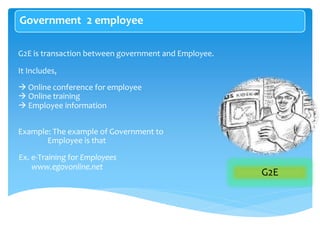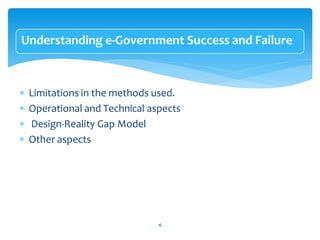E governance.pptx
- 1. E-GOVERNANCE Prof. R V Kolhe Assistant Professor Department of Civil Engineering Sanjivani College of Engineering, Kopargaon
- 2. In simple word, E-Governance is nothing but a mediator between government and citizens. It is the use of a range of modern information and technologies by government to improve efficiency ,service etc. i.e. Internet,mobile,local area network 1. E-governance
- 3. E-governance can be defines as use of information & communication by government to enhance the range, quality of information & services provided to the citizen in an cost effective manner. Introduction of e-Governance
- 4. E-Government can transform citizen service provide access to information to empower citizens enable their participation in government and enhance citizen economic and social opportunities so that they can make better lives, for themselves and for the next generation. Why E-Governance
- 5. types of e - governance G2G G2E G2B G2C
- 6. 5 Types of Interactions in e-Governance
- 7. Government 2 citizens G2C is transaction between government and citizens. It includes, Basic citizens services such as online registration of birth/death/marriage certificates Health care, education services etc. filing of income taxes Example: The example of Government to Citizens is that National Portal of India India.gov.in G2C
- 8. Government 2 business G2B is transaction between government and Business. It includes , Dissemination of policies, memos etc. Government rules and regulations. Business information Application forms, renewing licenses, registration, payment of taxes. Example: The example of Government to Business is that Business Portal of India Business.gov.in G2B
- 9. Government 2 employee G2E is transaction between government and Employee. It Includes, Online conference for employee Online training Employee information Example: The example of Government to Employee is that Ex. e-Training for Employees www.egovonline.net G2E
- 10. Government 2 Government G2E is transaction between between the central/national and local governments, and between government department and agencies and organisation. It Includes, Records by state government Schemes,plan,Initiatives Example: The example of Government to Government is that e-governance standard Portal of India http://egovstandards.gov.in G2G
- 11. E-GOVERNANCE BEST PRACTICES Fast & easy services Increased accountability Increased transparency Reduced corruption Increased efficiency due to connectivity Tickets & fines E-polling tax filing E-voting Vehicle registration Transaction
- 12. Better access to information and quality services for citizens. Simplicity, efficiency and accountability in the government. Expanded reach of governance. 11 Benefits Of E-Governance
- 13. Lack of Integrated Services Lack of Key Persons Population Different Languages 12 E-Governance Challenges Specific to India
- 14. Governance Transparency People’s participation Promotion of a democratic society Public services Efficient, cost-effective and responsive governance Convenient services to citizens and businesses Greater citizen access to public information Accountability in delivery of services to citizens Management Simplicity, efficiency and accountability Managing voluminous information and data effectively Information services Its Relevance to India
- 15. Customs and Excise (Government of India) Indian Railways (Government of India) Postal Department (Government of India) Passport / Visa (Government of India) CARD – Registration Project (State Government of Andhra Pradesh) LOKMITRA (State Government of Himachal Pradesh) 14 Initiative Till Date
- 16. Success and Failure in e-Government Projects Classification Percentage Success 15%- Partial Failure 60%+ Total Failure 25%+ 15
- 17. Limitations in the methods used. Operational and Technical aspects Design-Reality Gap Model Other aspects 16 Understanding e-Government Success and Failure
- 18. e-governance is playing an increasingly important role in modern governance. Various agencies of the government & civil society organisations have taken a large number of initiatives across the country. e-governance initiatives can be successfully implemented in the 28 states & 7 union territories covering more than 1 billion population. This capacity is show, India would further strengthen the strong & dynamic democratic institutions & thereby secure growth & development for all its citizens. Conclusion


















